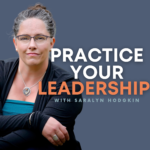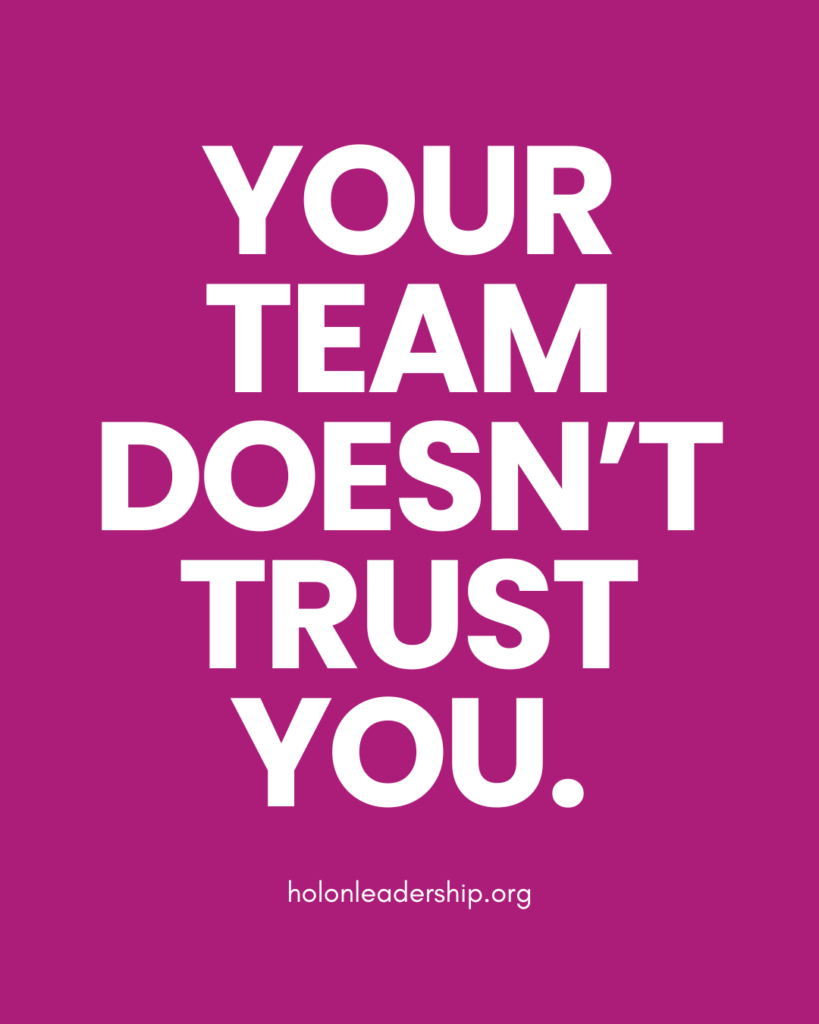77. Your Team Doesn’t Trust You. Here’s Why.
If your team feels disengaged, disconnected, or like they’re just going through the motions—it might be a trust issue.
In this episode, we break down the quiet signals that your team doesn’t trust you—and what to do about it.
You’ll learn how disengagement can be a symptom of low trust, what it really means to create psychological safety, practical ways to invite input, model vulnerability, and build connection, and why your own trust in your team is essential.
Because trust is the foundation of performance, creativity, and resilience. And rebuilding it starts with you.

Listen on
Resources
- Build your resilience with our brand new minicourse
- Subscribe to our newsletter for monthly community exclusive worksheets
- Follow us on Instagram and LinkedIn for more free resources
- Explore Amy Edmondson’s resources around psychological safety

Transcript
Transcript is AI auto generated. Please excuse any typos.
I’ve had a lot of talk about trust in teams lately, and, um, if your team is, if you’re sensing that it’s disengaged, that it’s disconnected, or maybe your team, you’re just feeling like it’s just going through the motions, there’s a good chance, folks, that trust is a real issue here. It’s not effort, it’s not talent, it’s not head count.
Um. It can be all about trust. And in this episode we’re gonna unpack some hard truth, that it could be that your team doesn’t trust you, and this is gonna be why. And this is not about blame, it’s about self-awareness. It’s about taking the time and the intention for self-reflection ’cause if you’re a leader, you’re always creating culture and influencing culture.
Whether you mean to or not, and trust is the foundation of engagement and creativity and performance, and so let’s dig in to some of the reasons why your people might be checked out, and more importantly, specific things you can start doing to try to rebuild the trust that is needed to buy in again.
Let’s, let’s dig into it. So first piece that you might, when you’re looking around your team that you might see is that people have stopped speaking up. Um, sometimes this happens because people just don’t believe that anything’s gonna change. The same thing is going on, the same conversation is happening, the same issue is arising.
And here as a leader, it’s about noticing that and asking yourself, okay, hold on. What am I doing with, let’s say the input people are giving me? Do I? Do I close the loop on that? Do I go back to my colleagues, colleagues when they’ve offered some input in a team meeting in a one-on-one, wherever it is, am I taking note of, of what they’ve offered and then circled back to them and said, Hey, that input, here’s what I did with it.
Hey, thanks for that, that feedback on that piece of work, what I did with that feedback is X, Y, and Z. Hey, that input that you gave last week. I reflected on it and we can’t use it just now ’cause our, our we, we don’t have X, Y, and Z to be able to do A, B and C at this time. But I’m gonna keep that idea ’cause I think that’s a great one and I’ll loop back to you and explore more when the opportunity comes up or whatever it might be, right?
Or, hey, that input was great, we just can’t use it right now. Please keep bringing it, man. Love that energy. Right? So are you closing the loop on when people are providing offers and input and feedback and, and the, you know, the second part to this is, are you creating. The brave space that’s required for people to choose speaking up.
’cause people can get their jobs done and not share input and not choose anywhere on the continuum of vulnerability to step in and step up to share something. And they may not tell you that they don’t see anything changing, that you just may feel them disengaging and disengagement right now folks, it is at a low Gallup research, HBR articles,
and so on. Like there’s so much out there right now that is showing that employee engagement is really quite low for a whole, whole host of reasons. And you know, there’s, there’s a place here to be able to create the cultural aspect in your team for people to want to come and engage and speak up, like already their engagement is low.
And if you haven’t created a space where people are choosing the bravery to share even the smallest thing, then what do you need to do differently? And sometimes we feel like the lack of. Engagement, that disengagement is a motivation issue, which has gotta motivate, motivate them more, right? When actually it can be a significant trust issue.
It can be a lot of different things, but it can be a trust issue and focusing on psychological safety, like get into some Amy Edmondson work and so on where you can create or try to work and co-create the conditions for, you know, psychological safety, bravery. There are different terms that people use, but it’s one where you can invite input, invite pushback.
Invite the dissenting, the, the dissenting voice, the devil’s advocate voice, uh, be able to reward and have gratitude for candor and model it. Model the active listening that’s required, the listening without defensiveness, right? There’s also a place here, I think, around the kind of cultures we create where we say.
That mistakes are welcome, but the behaviors don’t go along with that. It’s very fixed mindset world versus growth mindset world. Right? And could it be that consciously or probably subconsciously, you’ve created a culture where mistakes are perceived as punished. Right? Or that learning is great as long as we’re learning and making the right choices.
And here the action for you is to be able to model learning in real time. Hey folks, you know what? I just wanted to share that I got something wrong last week. It was X, Y, Z, and here’s what I’m taking away from it. Right. Just being able to share that kind of experience or being able to an answer with, yeah, I don’t know the answer to that.
I’ll loop back and I’ll find it, or not sure we’re gonna get an answer for that. What can we do now anyway? Or, yeah, man, I said X and I was, I was wrong. Right. When’s the last time you said anything like that? Or offered anything like that? If we’re modeling, always having to be right then it doesn’t create the conditions for people to speak up, to be learningful to engage.
And so being first, being the first to be vulnerable, to say, I’m not sure, or I missed that without apologizing for being human, but being able to model what you want to see in others is definitely a first step. I think the other thing here as we do self-reflection is you can look around your team and see people having capability, maybe even some capacity, and, and, and doing their jobs and doing them well.
Um, but they’re not bringing their energy. They’re not bringing their ideas, their, their or their care or their creativity. And so part of what we need to reflect on is, am I, am I driving too hard of just getting stuff done or can I step back a bit And, um, in one-on-ones, right, ask open-ended questions like, Hey, what’s something you’d love to improve or innovate in this piece of work, or for your leadership or in this space?
And just being able to see what’s on people’s minds and where they’re at. Part of this is creating the space of relationship, and it is relationship that fuels the productivity that we seek to accomplish the projects, the goals, and part of that means aligning or standing beside people. And understanding where, where their motivation comes from.
Calling out when you don’t see someone’s energy at the table and getting curious about why, not in a punishing way. Just like, Hey, what’s going on for you? And it might be something’s going on in their world, it might be, phew. I don’t know. I didn’t notice. It might be, yeah, I know that I’m really good at creating these spreadsheets, but
it doesn’t give me any joy, and I am like bored. Right. It might be that the work itself, even if it needs to get done, it’s really good to know, wow, you’re not motivated and you need new learning challenges. Okay, so let’s, we need to talk that through, right? And being able to stand alongside people to see what’s going on and also reflect in of yourself, right?
What’s the, what’s, what’s the, what’s the arena that you’re creating? This is. This is essential work. Um, another one I think that, you know, if I curl off of that, is around the idea of productivity. And we can get really focused on impact results using KPIs to drive the work. Um. But sometimes it’s not just a motivation issue or an energy and care issue.
It can be like, I have no idea where the company’s going anymore. I think it was in Gallup’s latest research, if I’m not mistaken, like their 2025 research that there is a growing discrepancy in understanding. Or even being connected to organization mission anymore, like aside from employee engagement, aside from wellbeing, like just its own indicator in and of itself is that I just, I don’t as, as, as a, as an employee, I just don’t know where the company’s even going.
Even if you have narratives and you have your annual reports that you get people to read or your CEO is. Or your executive director is talking through the mission. People just feel a disconnect. And so some of the small things that we can do is, is sometimes we get really lost in, in the work itself.
Right? When what can be really helpful sometimes is, is starting a meeting with a bridge point. Right. Like, why are we having this meeting? How does it connect to the work that connects to this project that connects to this organization? Like what is the bigger picture here? Part of your job is a storytelling rule, right?
So how can you take a moment to just take a, make a 30-second narrative link to say. To say what’s going on here and connect to mission, to create meaning people are yearning for meaning. So what is the meaning here? And, and you know, you can have a perch that nobody else has, have a horizon line that others just don’t see, and so that, that is a privilege and an opportunity and a gift to be able to provide other people with, with some narrative so they can make sense of what the heck is going on and what’s the bigger picture, and be able to make connections.
It is not always about just getting the work done, right. It is about creating that meaning and connection and belonging that helps people say, oh yeah, I wanna be engaged here, right? I wanna take the risk to speak up because I’m engaged here. Yeah. And so I think that the curl off of that is that for many of us, we need to look at our calendars and see where are you actually spending your time.
And part of that means that if your calendar is filled with tasks and project meetings. Um, without any time that shows the value or connection with people and in relationship that sends a message. And if there’s no walk and talks or even quick check-ins or, or meetings that you know, uh, you know, running quarterly meetings to say, Hey, how are you?
Like, let’s step back off the dance floor of the work. How are you doing? Sitting, wherever you’re sitting, how is our communication going between us? How are you feeling? What are you celebrating over the last quarter? Like if, if, if, if there is no being present without agenda of the work to drive this result forward and instead having relational connection, then you gotta ask yourself like, am I here just to drive the work?
And if so. Then I’m ignoring a key part of my job, which is to help be in service to the learning and development and connection of people in service of their growth. Because whether it’s in your job description or not, and it should be by the way, then it is part of, it is part of your work, and, and so another curl off of that then is that every person you work with.
They all work differently, like the neuro spiciness, the introvert, extrovert, like everybody works differently and part of your job is not just to have a one widget way, right? Part of the work is to be able to reward the visible hustle in some, um, and not ignore the quiet contributions of others. Being able to ask people, how do you like to have your work recognized?
Being able to be situational with people and what they need. Do they need a coach at that moment? Do they need some support? Some support, or do they need complete autonomy? Right? So. Part of, part of your work is to understand not just the work, but the humans in which you’re in relationship doing the work and creating those connections and being in service to those humans to help amplify, amplify their greatness.
Of course, holding accountability in the work, and I think I’ll, I’ll, I’ll, I’ll leave it with this one, which is that. If you are recognizing that people don’t trust you to the degree or in the ways that you would like, it could be that you don’t trust them. And what I mean by that is the way in which you work needs to demonstrate, demonstrate trust.
That means delegating outcomes, not just tasks. It means the action of delegating the outcomes of pieces of work. It means providing places of autonomy, which means people may not do it the way you would do it. It may even meal mean that it doesn’t get done the way you would get it done. Or it may mean that, uh, people make mistakes and hiccups ’cause they don’t have quite the same experience that you do.
And that is part of the world that we’re, that, that you’re trying to cultivate is a growth mindset where we’re learning and developing in ways that, that people can grow by having autonomy, by, by having delegation and accountability, there’s no doubt about it. By being able to have the practice of communicating expectations, which works in all directions, and by holding a practice of accountability and not shying away from that.
We’re just trying to get it roughly right here, folks, and do it in relationship with one another so that we can create places where people can thrive, which means that cultivating trust, which again, is the foundation of engagement and creativity and performance and meaning, that, that, that is part of the work wherever we show up.
You’ve got this self-reflect folks and stay in the practice.
Join Our Newsletter
Subscribe to our newsletter today and receive a FREE reflective workbook to guide you through my Top 5 Leadership Practices.

 Apple Podcasts
Apple Podcasts YouTube
YouTube Spotify
Spotify